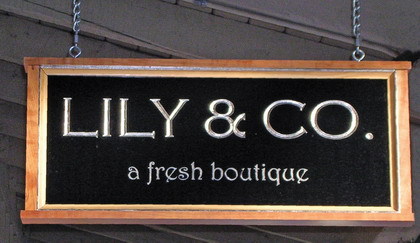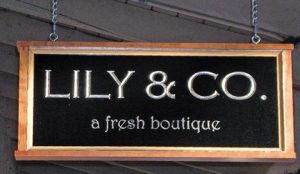Whether it’s called serendipity, karma or carpe diem, many of life’s greatest adventures derive from transforming happenstance into an enriching experience. As an ambitious art student, Torrey Webster followed this path with his career. And, although his initial plans fell through, he forged his own sign-industry path and has grown his shop, Jackson, WY-based Exposure Signs, into a full-service, thriving signshop in a tourist-friendly enclave that offers diverse, steady work.
Moreover, being open to new ventures has landed him a reputation that lures out-of-state customers. Though he never envisioned such a lengthy stay in Grand Teton country, Webster foresees continued growth through perfecting his craft and consistently providing quality products and service.
Surfboard to snowboard
As a student at a Tampa, FL, community college, Webster studied screenprinting and etching as part of a fine-arts curriculum. One summer between classes, a friend who’d migrated west convinced him to take a road trip. A trip through the Jackson Hole area and the surrounding Teton mountain range swayed Webster to move west 13 years ago.
“It was just such a beautiful place, a sharp contrast from Florida’s flat, humid coastal areas. I fell in love at once,” he said.
Advertisement
Webster aspired to apprentice for Mike and Darla Jackson, then proprietors of Jackson Signs. However, the Jacksons sold their shop to open Golden Era Studios, and the new owner elected not to hire additional help. Undaunted, Webster moved to Jackson Hole and went to work in a local snowboarding shop – a former avid surfer, he traded in his boogeyboard and assimilated to cold-weather extreme sports – while cutting his professional teeth from his home garage.
Webster spent most of his early years fabricating banners, temporary construction signs and other vinyl graphics, and admits that he endured significant trial and error as he perfected dimensional-signmaking techniques. Wisely, he enlisted an expert’s tutelage.
“I attended Larry Whan’s signcarving school [in Banff, AB, Canada], and it really elevated my career,” Webster said. “I learned to perfect many carving, fabricating and finishing techniques while working with wood panels. Learning to craft signs from natural wood – and having to contend with grains, knots and splinters – really honed my skills.”
Getting it done
Buoyed by his newly developed, signmaking acumen, he purchased a sandblaster and air compressor and stepped up his dimensional-sign fabrication efforts. He also outfitted his shop with a 30-in. Roland DGA Corporation VersaCamm VP-300 solvent-ink printer-cutter and a Graphtec cutting plotter of identical width, as well as a Daige cold laminator.
Although Webster has embraced digital printing, he still uses hand tools and traditional carving implements to craft his dimensional signs. To form his patterns, he cuts most substrates with a DeWalt scroll saw and, for fine carving, he uses chisels, gouges and rasps from Selt – a 150-year-old, German company.
Advertisement
Although customers in most places prefer an impeccable sign appearance, many area businesses that feature metal signage prefer a weathered, rustic appearance that befits an “Old West” image. To accomplish this, he incorporates an acid-dense compound that decays the substrate to a dark-brown or reddish tint, which he finishes with a clear, lacquer topcoat.
However, plying his trade within a relatively modest, 1,700-sq.-ft. space requires enterprising solutions to satisfy customer needs. Webster fabricates basic metalforms inhouse, but, for more intricate pieces, he contracts a local welder. And, for waterjet or plasma cutting, he sends his signs to an Idaho Falls, ID-based outfit.
Webster’s hankering for extreme sports has helped him garner significant work. Working for a local snowboarding shop and microbrewery when he initially moved to Jackson Hole helped him generate potential customers, and paragliding aficionados who flock to the area generate an unusual opportunity.
A local paragliding tour and equipment-rental shop operator had created an illuminated, Frisbee®-like disc, and he sought to promote it to his paragliding customers. Webster helped him find a solution.
“It took considerable trial and error to find a suitable fabric we could plotter-cut, and that could be stitched inside a paragliding parachute and withstand those conditions,” he said. “Ultimately, we used a medium-density, adhesive cloth from Seattle Textiles, which we plotter-cut by applying more pressure than we would with standard vinyl.”
He’s also partnered with Tim Tasker, proprietor of TGT, a local decal and sticker purveyor, to inkjet-print thousands of tourist-themed promotional items that have been shipped throughout the United States. Webster mused, “When you run a signshop in a small town, you have to be creative and seek any promising market you can find.”
Advertisement
The Hole story
Although Jackson only claims 8,000 year-round residents, Webster estimates the Jackson Hole resort area attracts from 600,000 to one million visitors annually. The tourist traffic waxes and wanes with the seasons – winter travelers tend to book lengthy stays; summer sojourners linger briefly, and visitors sparsely populate the town during spring and autumn. The windows of lagging tourism provide Webster with an ample window to fabricate and install his sign.
Customers vary from the highly sophisticated and directed to those who darken Exposure’s door with muddled business plans and a dire need of design help. For those in the latter category, Webster will design sketches by hand and prepare a short list of fonts he thinks will suit their business.
Once he’s received client approvals, he begins his process with Adobe® Photoshop® or SA Intl.’s FlexiSign Pro – Webster tends to work with Photoshop for plotter-cut graphics and FlexiSign for dimensional signs. For inkjet-printed graphics, he’ll use Roland DGA’s VersaWorks software – he lauds the system’s RIP-and-print functionality.
Like many resort towns, Jackson Hole maintains relatively rigid sign codes and standards. Local officials have developed a formula that permits 1 sq. ft. of signage per every 3 linear ft. of store frontage. Also, backlit signs are forbidden throughout the city, and Jackson’s historic district prohibits any sign materials besides wood and paint.
“Given our temperature extremes – -30° F in the winter, mid-90s in the summer – HDU has proven much more reliable,” he said. “But, it’s their rule; they have a very particular image they want to convey, so I respect it.”
Webster’s snowboarding compatriot, W.D. Barry, who’s worked intermittently at Exposure for three-and-a-half years, now works in the shop full-time most of the year. And, despite the almost daily gloom-and-doom economic reports recounted on news shows and cable networks, he said the shop remains at or near workload capacity.
In the near future, Webster will consider buying a CNC router to ramp up his production capacity, and shop growth may be a long-term possibility. He may not stay in Jackson Hole permanently, but Webster feels relatively settled in his new home.
“I never thought I’d move to Wyoming, and I never thought I’d be here this long,” he said. “But, I’ve got a great business and a great life here. Things are good.”



 Tip Sheet1 week ago
Tip Sheet1 week ago
 Photo Gallery2 days ago
Photo Gallery2 days ago
 Ask Signs of the Times4 days ago
Ask Signs of the Times4 days ago
 Real Deal2 weeks ago
Real Deal2 weeks ago
 Benchmarks1 week ago
Benchmarks1 week ago
 Women in Signs2 weeks ago
Women in Signs2 weeks ago
 Photo Gallery1 week ago
Photo Gallery1 week ago
 Women in Signs1 week ago
Women in Signs1 week ago










